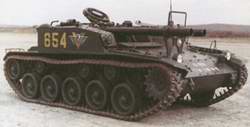| Designation: | Type 60 106mm SP |
 |
|---|---|---|
| Manufacturer: | Mitsubishi Heavy Industries | |
| Product type: | Armoured Vehicles | |
| Name: | Self-propelled gun |
Two prototypes of the self-propelled recoilless anti-tank system were built under the direction of the Technical Research and Development Headquarters of the Japanese Ground Self-Defence Force, one by Komatsu (called the SS1) and the other by Mitsubishi Heavy Industries (called the SS2), both powered by a six-cylinder diesel which developed 110 hp. The prototypes were completed in December 1956 and were tested until December 1958.
In 1957, it was proposed to arm the vehicle with four recoilless rifles, instead of the two 105 mm weapons fitted to the prototypes, to increase the hit probability, but with the adoption of the 106 mm recoilless rifle this reverted to two.
As a result of trials with the second series of prototypes it was decided to build a third and final series of prototypes with weight increased to 7,500 kg, a modified diesel engine, a new transmission with four forward and one reverse gears, a two-speed auxiliary transmission and a wet multidisc hydraulically operated clutch. Three of the third series prototypes were built by Komatsu under the designation SS4 and were tested from May 1959 to March 1960. As a result, the clutch was changed to a wet multidisc mechanical type. In September 1960, the vehicle was accepted for service as the Type 60 Self-propelled 106 mm Recoilless Gun.
Production of the vehicle was undertaken by Komatsu. The first production model, the Model A, was replaced in 1967 by the Model B which was basically a strengthened Model A. In 1974 the Model C powered by a commercial model Komatsu SA4D105 four-cylinder water-cooled diesel engine developing 150 hp at 2,800 rpm, entered production. The Type 60 twin 106 mm self-propelled recoilless gun was produced at the rate of 10 to 20 vehicles a year and by December 1977, 252 vehicles had been built. Production was completed in FY79.
There are no known plans for these systems to be upgraded. Japan is the only country in the world still to deploy a system of this type.
Each year small numbers of Type 60 twin 106 mm self-propelled anti-tank guns have been withdrawn from service and by 1999 it was stated that 160 remained in front line service. Since then additional vehicles have been phased out of service. It is understood that by 2007 about 100 Type 60 systems remained in service.
There is no direct replacement for the Type 60 twin 106 mm system but its role is now being taken over by longer-range anti-tank guided weapon systems.
The hull of the Type 60 is of welded and riveted steel armour construction. This provides the occupants with protection from small arms fire and shell splinters. The driver is seated on the left side of the vehicle towards the front and has a single-piece hatch cover that opens to the rear in front of which are three day periscopes. The commander is seated in the middle of the hull to the left of the two recoilless rifles and his position is attached to the recoilless rifle mounting, so when they are raised into the firing position he is at the same height as the weapons. The commander has a single domed hatch cover that opens to the rear, in front of which is a day periscopic sight. There is also a vision block to his rear. The loader is seated to the left of the commander and has a single-piece hatch cover that opens to the left and a retractable day periscope for observation to the rear.
The air-cooled diesel engine is at the rear of the hull and power is transmitted to the manual transmission at the front by a propeller shaft. The torsion bar suspension either side consists of five dual rubber-tyred road wheels with the drive sprocket at the front, idler at the rear and three track-return rollers. The first, second and fifth road wheel stations have a hydraulic shock-absorber. The tracks can be fitted with rubber pads when operating on roads and wider tracks can be fitted for operating in snow. The Type 60 has no NBC system and no amphibious capability.
Main armament consists of two 106 mm Type 60 breech-loaded recoilless rifles which were manufactured by Nihon Seikojyo and also fitted singly to Japanese Ground Self-Defence Force jeeps. They have a maximum range of 7,000 m and an effective range of 1,100 m against tanks. A 12.7 mm spotting rifle manufactured by Howa Kogyo is mounted on the right recoilless rifle. The two recoilless rifles are mounted parallel to each other on the right side of the hull. When lowered they have an elevation of +10°, a depression of -5° and a traverse of 10° left and right. When raised they have an elevation of +15°, a depression of -20° and a traverse of 30° left and right. The weapons are raised into the firing position by a hydraulic/electric power system, but if this fails they can be raised by a hand pump. Eight rounds of HEAT or HE ammunition are carried. A 75 cm stereo range-finder is also carried on the vehicle and recently a night sight has been mounted on the left 106 mm recoilless rifle.
The effectiveness of the 106 mm HEAT rounds against modern conventional steel armours is now highly questionable.
|
||||||||||||||||||||||||||||||||||||||||||||||||
 |
 |